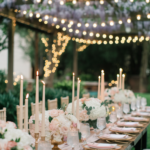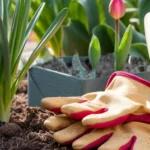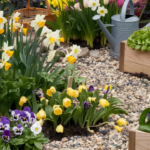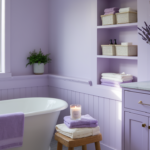Spring is the perfect time to refresh and enhance your garden with new plants, features, and decorative elements. Whether you’re a seasoned gardener or just starting, adding the right touches can transform your outdoor space into a thriving, beautiful oasis. From colorful flowers to practical tools, this list highlights the best and most popular additions for your garden this spring. Let’s get started!
1. Pollinator-Friendly Flowers
Adding blooms like lavender, sunflowers, and marigolds not only brightens your garden but also attracts bees, butterflies, and other beneficial pollinators. These flowers help improve the health and productivity of your garden.
Adding blooms like lavender, sunflowers, and marigolds is one of my favorite ways to bring life and energy to my garden. Not only do these flowers add stunning pops of color, but they also work double-duty by attracting bees, butterflies, and other beneficial pollinators. But here’s where I like to add my own twist to make them even more effective and unique in the garden.
First off, placement is everything. I’ve learned that planting these blooms strategically throughout the garden—not just in one spot—helps draw pollinators to every corner. Lavender, for example, does wonders near veggies like tomatoes or cucumbers. The bees can’t resist it, and it makes a noticeable difference in how well those plants produce. Marigolds? I always tuck them near squash and beans because not only do they attract pollinators, but they also help repel pests like aphids and nematodes. It’s a win-win.
With sunflowers, I go beyond just planting them in the back of the garden for height. I’ll mix dwarf varieties into the flower beds or even in containers near my patio. What people don’t realize is that sunflowers are not just for show—they’re a magnet for bees and butterflies, but they also bring in beneficial birds that help keep pests in check. Plus, once they’re done blooming, the seeds are a fantastic treat for wildlife or even for you if you roast them!
Now, here’s my secret weapon: I like to create what I call “pollinator pathways.” I plant lavender, marigolds, or other bright blooms in clusters that lead from one area of the garden to another. This essentially creates a guide for bees and butterflies to explore the entire space, ensuring that no part of the garden gets neglected. I also mix in companion plants like basil or dill, which not only enhance the pollinator appeal but also bring their own benefits to neighboring plants.
Another tip? If you really want to give your pollinator-friendly blooms a boost, avoid overhead watering as much as possible. Pollinators like bees are less likely to visit plants with wet blooms or leaves, so watering at the base of the plant keeps things dry and inviting for them. I also try to stick to organic gardening practices—no harsh pesticides or synthetic fertilizers—because I’ve seen firsthand how even a little chemical residue can drive pollinators away.
Adding lavender, sunflowers, and marigolds isn’t just about pretty flowers—it’s about creating a thriving, balanced ecosystem in your garden. With a little thought, some strategic planting, and a few personal touches, these blooms can do so much more than brighten your space—they can transform your garden into a buzzing, vibrant hub of life and productivity. Trust me, once you see the results, you’ll never skip these pollinator favorites again!
2. Raised Garden Beds
Raised beds are perfect for growing vegetables, herbs, or flowers in an organized and efficient way. They improve soil drainage, protect plants from pests, and make gardening more accessible.

3. Decorative Garden Pathways
Add charm and structure to your garden with decorative pathways made of stepping stones, gravel, or wood chips. These paths not only look beautiful but also make navigating your garden easier.

4. Bird Feeders and Bird Baths
Welcome birds to your garden by installing feeders and baths. Birds help control pests and bring life to your outdoor space with their songs and movement.
Picture This: A charming birdbath surrounded by blooming flowers, with birds perched on the edge. Nearby, a bird feeder hangs from a tree, with sunlight filtering through the leaves.
5. Vertical Gardens
Maximize space and add a unique design element with vertical gardens. These are perfect for small spaces and can be used to grow herbs, vegetables, or even decorative plants.
Picture This: A vertical garden made of wooden pallets filled with pots of herbs, succulents, and trailing vines. The setup is placed against a sunny garden wall, adding both greenery and style.
6. Seasonal Vegetables and Herbs
Spring is the ideal time to plant cool-weather vegetables like lettuce, spinach, peas, and carrots, as well as popular herbs like basil, cilantro, and parsley. Fresh produce right from your garden is hard to beat!
Picture This: A garden bed filled with neat rows of leafy greens, herbs, and small sprouting vegetables. The soil looks freshly turned, and a small trowel rests beside the bed.
7. Composting Bins
Set up a composting system to recycle kitchen scraps and yard waste into nutrient-rich compost. This is a sustainable way to improve soil health and reduce waste.
8. Solar Garden Lights
Add ambiance and functionality to your garden with solar-powered lights. They’re eco-friendly and perfect for illuminating pathways, flower beds, or garden features at night.
Picture This: A row of small solar lights glowing softly along a garden path. The lights cast a warm glow on the surrounding plants, creating a magical evening atmosphere.
9. Edible Flowers
Add beauty and flavor to your garden with edible flowers like pansies, nasturtiums, and calendulas. They make a unique addition to salads, desserts, and drinks.
Picture This: A garden filled with colorful edible flowers, their petals glistening in the morning dew. A small basket sits nearby, ready for harvesting blooms.
10. Mulch and Ground Cover Plants
Mulch helps retain moisture, prevent weeds, and regulate soil temperature. Ground cover plants like creeping thyme or clover are a beautiful and low-maintenance way to fill in bare areas.
Picture This: A garden bed with fresh mulch spread around blooming flowers and shrubs. Nearby, creeping thyme carpets the edges of a path, adding lush greenery.
11. Garden Arbors and Trellises
Add height and structure to your garden with an arbor or trellis. Use them to support climbing plants like roses, wisteria, or morning glories for a dramatic and romantic effect.
Adding an arbor or trellis to your garden is one of those design choices that instantly elevates the entire space—literally and figuratively. I love how these structures not only add height and drama but also bring a sense of structure and organization to the garden. Over the years, I’ve found a few tricks that make arbors and trellises even more impactful and unique.
For starters, placement is key. While most people might think to put a trellis along a fence or wall, I like to use them to create focal points or transitions in the garden. For example, placing an arbor at the entrance to a pathway or seating area creates a natural frame, making the garden feel more like an intentional, curated space. It’s like you’re stepping into another world, especially when it’s draped with climbing roses or wisteria in full bloom.
Now, let’s talk about plant pairings. Roses, wisteria, and morning glories are classics for a reason—they’re gorgeous and grow beautifully on trellises—but I like to mix it up with unexpected choices. Clematis is one of my favorites to pair with roses because their contrasting flowers add extra depth and color. For a more functional twist, I’ll grow edible climbers like beans or peas on a trellis alongside ornamental plants. It’s a great way to combine beauty with productivity, and guests are always amazed when they see flowers and food coexisting so perfectly.
One trick I’ve learned is to treat the area around the base of the trellis as part of the overall design. Instead of leaving it bare, I’ll plant low-growing flowers or groundcovers, like creeping thyme or alyssum, to soften the transition from the vertical to the horizontal. It creates a layered look that feels lush and full. For an arbor, I’ll add planters at the base with trailing plants like ivy or sweet potato vine to cascade down and add even more texture.
And here’s my favorite personal touch: I’ll string fairy lights or solar-powered lanterns through the trellis or arbor. At dusk, the structure transforms into a glowing, romantic centerpiece that keeps the garden magical well into the evening. Combined with the scent of climbing roses or wisteria, it’s a full sensory experience that makes the space unforgettable.
Finally, I like to think about durability and style. If you’re investing in an arbor or trellis, go for something that complements the vibe of your garden—whether that’s rustic wood for a natural look, sleek metal for modern elegance, or even a painted finish that matches your favorite blooms. And don’t forget to anchor them securely—nothing’s worse than watching your hard work topple over in a strong wind!
An arbor or trellis isn’t just a support for climbing plants—it’s a statement piece that brings height, structure, and a sense of romance to your garden. With a little creativity and the right plants, it’s one of the easiest ways to make your garden feel both organized and magical. Trust me, once you add one, you’ll wonder how your garden ever felt complete without it!

12. Native Plants
Native plants are adapted to your local climate, making them easy to care for and beneficial for the environment. They also attract native pollinators and require less water.
Picture This: A garden filled with native wildflowers and grasses, gently swaying in the breeze. Bees and butterflies flit among the plants, adding life to the scene.
13. Water Features
Install a small pond, fountain, or waterfall to add a soothing sound and visual interest to your garden. Water features can also attract wildlife like frogs and dragonflies.
14. Garden Seating
Create a cozy spot to enjoy your garden by adding a bench, swing, or outdoor chairs. This transforms your garden into a relaxing retreat.

15. Be Drip Irrigation Systems
Save time and water by installing a drip irrigation system. This efficient watering method ensures your plants get the moisture they need directly at their roots.
Spring is the perfect time to enhance your garden with these popular additions. From practical features to beautiful blooms, each item on this list will help you create a garden that’s as functional as it is stunning. Start planning today and watch your garden come to life this season!
Are you adding any of these to your garden this spring? Share your ideas in the comments or tag me on Instagram with #LifeAndSubscribe! Don’t forget to pin this blog for inspiration!ones and solar lights, with overlay text: “Transform Your Garden with These Stunning Additions.”
4. A vertical garden setup on a sunny wall with herbs and flowers, with overlay text: “15 Spring Essentials for a Beautiful Garden.”
5. A pin highlighting compost bins and soil preparation, with overlay text: “Prepare Your Garden for Spring Success!”
Let me know if this works perfectly or if any adjustments are needed!






